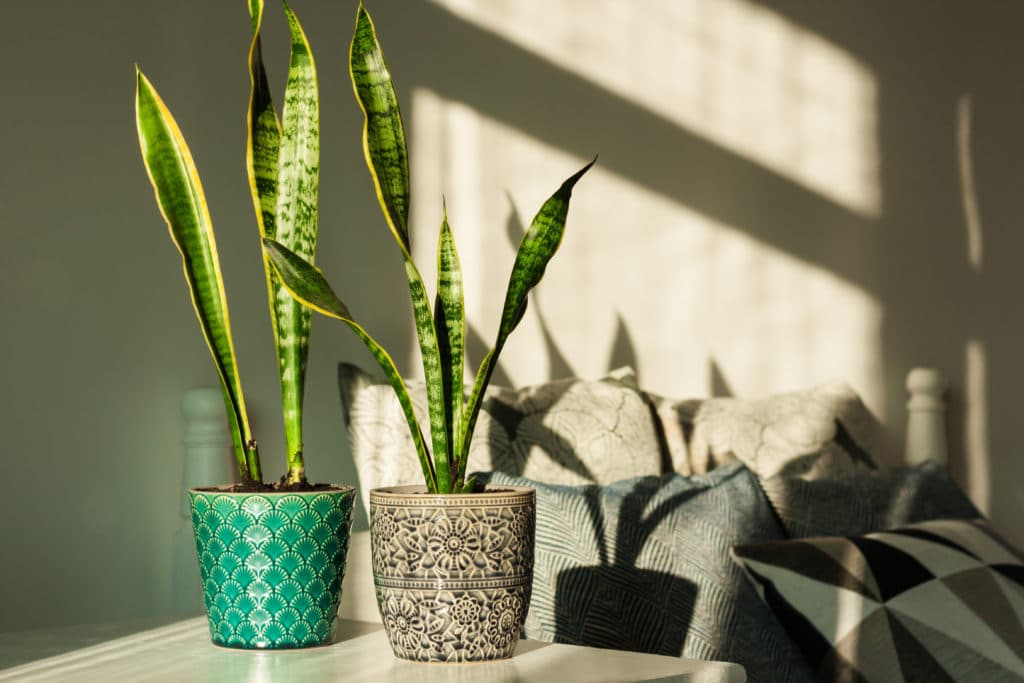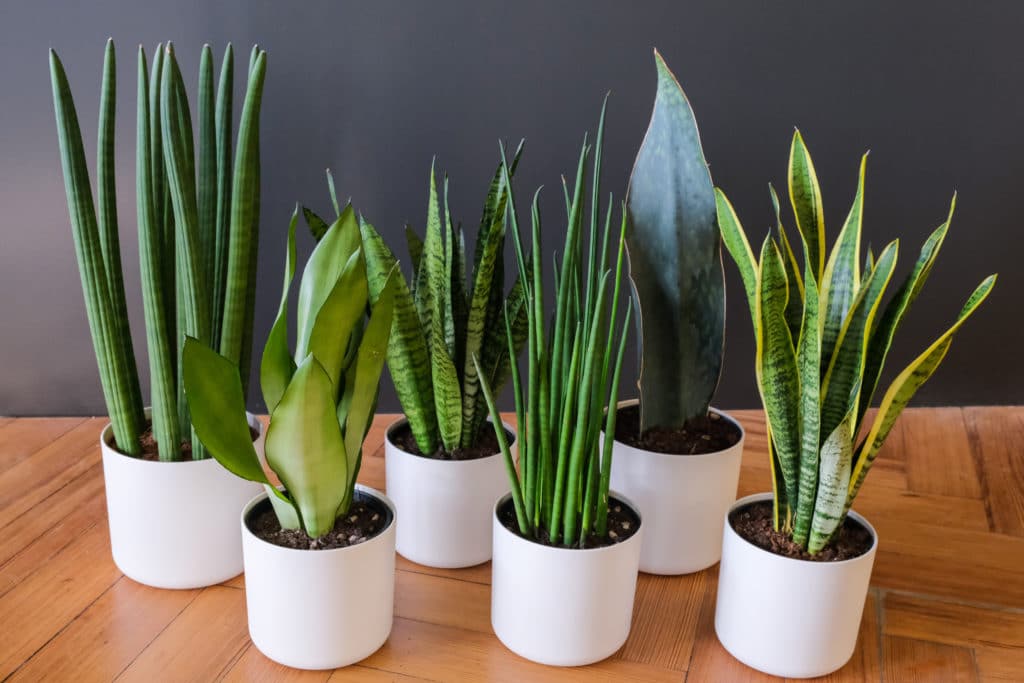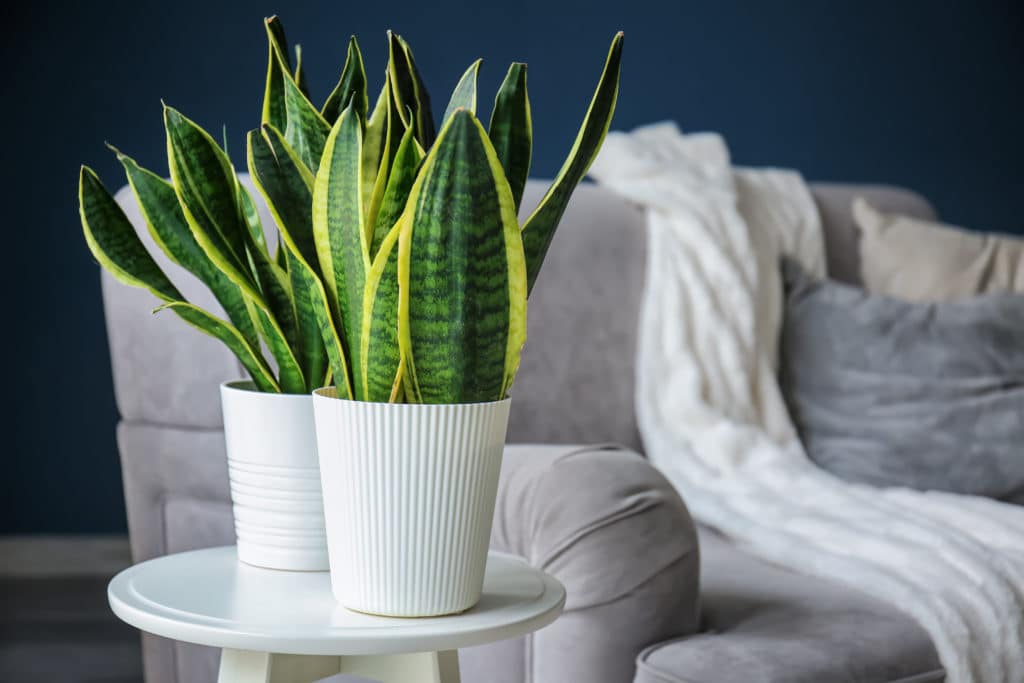
Sansevieria (Snake Plants) are some of the toughest plants you can find. Whether indoors, in your garden, or on your balcony, these spiky beauties can put up with almost anything.
They’re easy to grow, but there are a few things you should know. Keep reading for Snake Plant care as a houseplant – you’ll see how low maintenance they really are.
Snake Plant (Sansevieria) Care Tips
Size
Snake plants come in a variety of sizes, from small desktop plants to big floor specimens. Choose the size that’s right for you.
Watering
How often you water your snake plant depends on how much light it gets and the time of year. In general, they need watering about once a week. If your plant is in a pot with drainage holes, wait until the soil is dry before watering again; if it doesn’t have drainage holes, water until the excess drains out of the pot. Don’t let the pot sit in water or the roots will rot.
Sunlight
Snake plants need bright light but not direct sunlight – a spot near a window is perfect.
Fertilizer
Fertilize your snake plant once a month with a balanced houseplant fertilizer.
Pests and diseases
Snake plants are generally pest- and disease-free, but if you notice aphids or mealybugs on your plant, use insecticidal soap to get rid of them. spider mites can also be a problem; if you see webbing on the leaves, spray with water and then rinse with a hose.
Growth Rate
Snake plants grow slowly, so they won’t get out of control. As long as you provide the care your snake plant needs it will stay small and compact.
Temperature
If your snake plant is exposed to a temperature below 50 degrees Fahrenheit, it will go into dormancy and stop growing. Bring it back indoors if this happens.
Soil
A good all-purpose potting mix works well for Sansevierias (Snake Plants). Use a large container with drainage holes to avoid root rot.
Repotting & Propagation
It’s best not to repot Snake plants often – instead, just top-dress them by adding an inch or so of soil every couple of years when the roots have filled the existing soil. To propagate your snake plant, take a stem cutting in spring or summer and place it in a moist potting mix until new growth appears at the base of the cutting.
Sansevierias propagate easily by means of leaf cuttings or division.
Leaf cuttings are the easiest way to propagate snake plants, but division is very effective as well. If you choose to propagate snake plants by division, simply remove a fleshy root with a sharp knife and pot it up. Be sure to plant the root in moist soil, and wait for new growth to begin at the base of your snake plant.
Propagation by division is also a good way to control its size in small spaces.
Where to buy Snake Plants
You can find these low-maintenance beauties at any garden center near you; look online for big discounts on potted specimens too!
Don’t forget when shopping around not only to consider how much light the plant will get, how big it will grow and how often you need to water your snake plant but also how much space you have for the pot.
How to Grow a Snake Plant
Sansevierias generally need very little attention from their owners to thrive and survive long-term – but that doesn’t mean they’re indestructible!
In fact, it’s best not to treat them like cacti or succulents; if grown too dry for too long, they may start to lose their leaves.
The most essential thing to know is that they are prone to rotting quickly, therefore loamy soil with no drainage is required.
Leaf cuttings are typically used, but dividing is the simplest method to grow snake plants.
The fleshy roots develop from the roots and may simply be removed with a sharp knife and potted up. These should again be planted in soil that is not too dry and does not have any drainage.
Pruning
Remove leaves from the soil line or damaged or old leaves to stimulate new development with sterile pruning shears, scissors, or a sharp knife.
Pruning is best performed during the growing season-typically spring or summer-but it may be done at any time of year. It’s preferable to trim your snake plant when it’s in a growing period because pruning might stress it out.
Remove the highest leaves to regulate the height of your snake plant. Additionally, remove any dead or damaged leaves. Leaf removal encourages newer leaf development, so snake plant care may require pruning more than once a year.

Snake Plant Types
There are about 70 snake plant species in the world, but the most common one is Sansevieria trifasciata. This tall, spiky plant can grow up to two meters high and has dark green leaves with light stripes down the middle.
Dracaena marginata (or ‘Dragon’s Tail’) is another popular type of snake plant. It has long, narrow leaves that taper off into a point.
- Dracaena trifasciata ‘Hahnii’: It is sometimes called feather nest plant, since this slow-growing snake plant reaches only about six inches tall. The leaf clusters in a bird’s nest clump.
- Dracaena angolensi (formerly Sansevieria cylindrical): The leaves of this cylindrical snake plant are round and rigid, reaching up to a few feet in length. The leaves radiate from a focal point.
- Dracaena trifasciata ‘Laurentii’: The variegated snake plant has cream-colored leaf margins. This plant must be divided rather than propagated via leaf cuttings in order to grow.
- Dracaena trifasciata ‘Twisted Sister’: The plant’s leaves are striped horizontally in yellow variegated stripes. It reaches a height of approximately 14 inches.
- Dracaena trifasciata ‘Bantel’s Sensation’: The snake plant’s long, narrow leaves are white with vertical black stripes. It grows to be about three feet tall.
- Dracaena pearsonii: This plant, sometimes known as rhino grass, has succulent red-tinted leaves and grows to be about 12 inches tall.

Growing a Snake Plant From Seed
If you want to grow a snake plant from seed, it’s actually very easy. All you need is a potting mix, a little bit of water, and patience – snake plants take their time germinating!
Here are the steps:
Step One: Start by filling a pot with the snake plant seed starting soil mix.
Step Two: Water the mix so it’s moist, but not soaked. Then sprinkle your snake plant seeds on top of the soil and pat them down gently – just enough to cover them up! Put the pot in a warm place (about 75 degrees Fahrenheit) and wait for germination. It can take between one week and several months, depending on how hot or cold your grow room is – snake plants don’t like drafts or extreme temperatures. Keep checking that they’re still moist during this time by spritzing periodically if needed – you want their environment to stay humid without becoming soggy. If mold starts growing on top of the soil or leaves turn black, remove them immediately.
Step Three: Once your snake plants have come up, water them regularly and keep the soil moist at all times – snake plant seedlings are very small and need regular watering to stay healthy. You can also move it into a sunny window so they get plenty of light for photosynthesis. If you want, transplant them after two months or when their first set of leaves has developed fully (about three sets altogether). Now you know how to grow snake plants from seeds!
Growing Dracaena Trifasciata Outdoors in Containers
Snake plants make beautiful container houseplants too – particularly dracaenas like Sansevieria trifasciata. They’re naturally thick-stemmed with sturdy spiky foliage, so they do well in bigger containers. In fact, snake plants flower only when they’re growing outdoors in full sun!
Here are a few tips for planting snake plant cuttings or seeds outside:
Step One: Start by filling your container around one-third of the way with soil and then add water until it starts to drain out through the bottom – you want a light mix that drains easily but also holds moisture. Snake plant root ball is very dense, so don’t overfill your pot or try to bury any part of its roots. Then place some rocks at the bottom if drainage is an issue, which will help prevent rotting from sitting in wet conditions too long – this step isn’t necessary though.
Step Two: Add your snake plant cutting or seedling to the center of the pot and fill in around it with more soil, gently pressing it down so the roots are covered.
Step Three: Give your snake plants plenty of water at first – they’ll drink a lot since they’re getting used to their new environment. Continue watering them every two weeks or when the top inch of soil feels dry to the touch; you don’t want their roots sitting in water all the time. Mulching around your snake plants will help keep moisture in and reduce weed growth.
Step Four: Place your container outdoors in full sun (minimum six hours per day) and enjoy watching them grow! Dracaena trifasciata can reach up to three feet in height, so give them plenty of room.
All in all, if you want an easy-care houseplant that looks good almost anywhere, a Sansevieria (Snake Plant) is for you. These tough guys can take neglect or abuse – how many other plants can say that? – but with just a little love and attention they reward you by thriving in most conditions!
